Longevity
What is Longevity?
A common definition of “longevity” is the “amount of time your life lasts” or “typical length of life.” In the study of demography, the term “longevity” is sometimes meant to refer to especially long-lived members of a population, such as the recent study of Blue Zone regions of the world.
While most people equate longevity with a long healthy life, that thinking is not necessarily true. With today’s modern medical technologies, hospitals and doctors can keep people alive much longer (life span), but this doesn’t guarantee improved quality of life or health during that extended time (health span). There is a big difference between life span and health span. Life span is how long you are technically alive, and health span is the length of time you are truly healthy and thriving during that time. Ideally you want your life span to equal your health span.
The Bible tells us that we have the potential to live to be 120 years old. “…yet his days shall be one hundred and twenty years.” (Genesis 6:3) Scientists today confirm that mankind does indeed have the physical and genetic potential to live to be 120 years of age. There are many things we can do to optimize our diet and lifestyle which can help us achieve our full human potential to live a healthier and longer life.
To increase your longevity, the key is “Living Healthier and Younger Longer!”
Blue Zones and the Cultures of Longevity
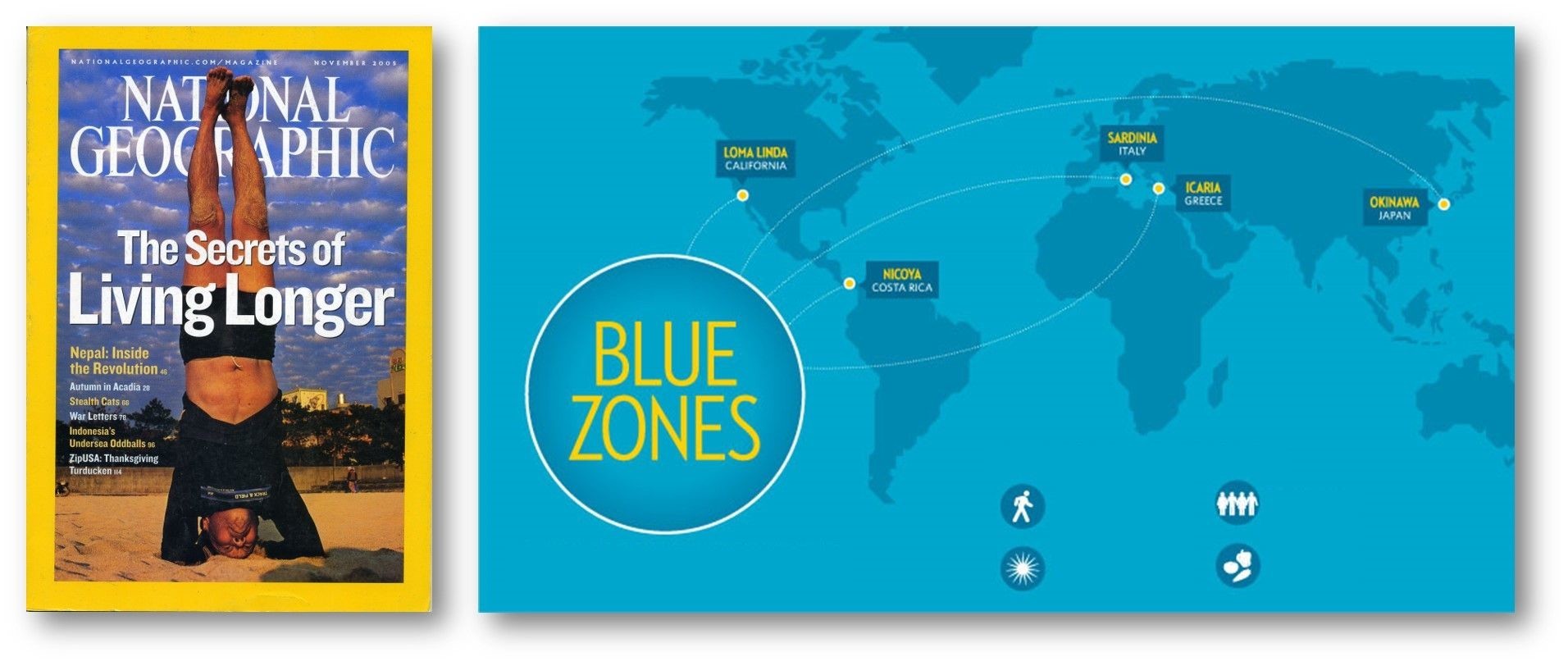
Blue Zones are an anthropological concept that describes and identifies the unique characteristic lifestyles and the environments of the world’s healthiest and longest-living people. The concept originally grew out of demographic work done by scientists drawing concentric blue circles on a map identifying clusters of villages in a region with the highest longevity of male centenarians. Areas within the blue circle they called a Blue Zone. Later they broadened that term to apply to other validated longevity areas found in the world. The term “Blue Zone” first appeared internationally as a concept in the November 2005 issue of National Geographic Magazine in its cover story, “The Secrets of Living Longer” by Dan Buettner. This special issue of National Geographic Magazine was so popular, it became the third largest selling in the magazine’s history. In the magazine, Buettner (often referred to as National Geographic’s “explorer of longevity”), identified three geographic areas of the world where people live the longest: Okinawa, Japan; Sardinia, Italy and Loma Linda, California, home to a large population of Seventh-day Adventists. After the magazine’s publication, he later discovered two additional Blue Zones; Icaria, Greece and Nicoya, Costa Rica. His research work offers explanations, based on empirical data and first-hand observations, as to why these populations live healthier and longer lives.
National Geographic “Explorer of Longevity” Dan Buettner discusses the BLUE ZONES
The five Blue Zone regions identified by Dan Buettner are further discussed in detail in his two National Geographic published books, The Blue Zone: Lessons for Living Longer from the People Who’ve Lived the Longest and The Blue Zones Solution: Eating and Living Like the World’s Healthiest People. Here is a summary of some of the interesting facts and observations about these fascinating Blue Zone cultures of longevity:
IKARIA, GREECE

This island in the Aegean Sea is located eight miles off the coast of Turkey. Its residents have one of the world’s lowest rates of middle-aged mortality. It appears to have the highest percentage of 90-year-olds on the planet – nearly 1 out of 3 people make it to their 90s. Ikarians have about 20 percent lower rates of cancer, 50 percent lower rates of heart disease and almost no dementia. The secret to this populations health and longevity is their healthy, plant-based Mediterranean diet. Their traditional diet represents the type of diet eaten during the time of Jesus. Plenty of vegetables and potatoes, wild greens, some fruit, legumes (especially garbanzo beans and lentils), and the use of extra virgin olive oil as the primary source of fat. Greek extra virgin olive oil is considered by many experts as the finest quality in the world as it is often made with varieties of olives that are the highest in polyphenol antioxidants.
OKINAWA, JAPAN

The largest island in a subtropical archipelago, it is recognized to be the home of the world’s longest living women. As a group, the Okinawans are among the longest-lived on Earth. They keep lifelong friends, eat small portions, and find purpose in their lives. Okinawans have a fifth the heart disease, and a fourth the breast and prostate cancer, and less than half the dementia seen in Americans of similar age. The Okinawans have a philosophy that everyone has an ikigai – “a reason for living”. Essentially, ikigai means a purpose for living, “a reason to get up in the morning”. A reason to enjoy life or “that which makes one’s life worth living.” It is believed that knowing or finding their purpose for being, is a driving force that contributes to their health and longevity.
In Okinawa, men are expected to live to about 84 and women are expected to live to almost 90. The Okinawans have one of the highest centenarian ratios: about 6.5 in 10,000 live to be 100 years of age. They eat mostly plant foods, with 80 percent of their calories coming from carbohydrates. On average they consume about seven servings of vegetables and about two servings of grains a day, along with two servings each day of flavonoid-rich soy, typically in the form of tofu. They don’t consume much fruit, and dairy and meat only represent about 3 percent of their calories. Most of their protein comes from plant sources, along with some fish.
OGLIASTRA REGION of SARDINIA, ITALY

Located in the mountainous highlands of an Italian island it is known for having the world’s highest concentration of centenarian men. Sardinian men keep active all the time. Many of them are shepherds. Their daily outdoor physical activities along with their work tending sheep is a lifestyle that contributes to less stress for the men, which may contribute to reducing their risk of cardiovascular disease and increasing their longevity. Many of the Mediterranean foods that contribute to the longevity in the Ikaria, Greece population, also add to the long life of those living in Sardinia. In the Blue Zone region of Sardinia studied by National Geographic, meat was eaten, at best, once a week. In the winter they almost never ate meat. Most of their foods come from the vegetables taken from their gardens. It is believed that good genes also contribute to the longevity of Sardinians.
NICOYA PENINSULA of COSTA RICA

A Central American country where residents have the world’s lowest rates of middle-age mortality and he second highest concentration of male centenarians. Residents in this part of Costa Rica seem to avoid heart disease, many types of cancer, and diabetes better than Americans. They spend about one-fifteenth of what the United States spends on health care.
The Nicoya’s diet is very high in carbohydrates – almost 70 percent of their total calories in a day. Their main carbohydrates are rice, maize, and beans. About 20 percent of their calories come from fat and about 10 percent of their calories come from protein. Most of their protein is plant-based coming from legumes. This low-calorie, low-fat, plant-based diet is very typical of the dietary pattern of other Blue Zone cultures of longevity. Typically, the people of the Nicoya Peninsula region of Costa Rica live mostly on beans, corn tortillas, and tropical fruits.
In addition to their healthy plant-based diet, the people of Nicoya have a strong faith community, strong social networks, and get regular moderate physical activity. All of which are added factors contributing to their health and longevity.
LOMA LINDA, CALIFORNIA - The Community of Seventh-Day Adventist Christians

Considered the “Blue Zone of America”, Loma Linda is a busy Southern California urban community with the highest concentration of Seventh-day Adventist Christians in the United States, where many residents live ten more years than the average American. Researchers have studied a group of Seventh-day Adventists who rank among North America’s longevity all-stars. As part of the tenets of Seventh-day Adventists doctrines of good health they avoid tobacco, alcohol, and caffeine. Their diet prohibits foods identified by the Bible as “unclean”, such as pork and shellfish (Leviticus 11; 20:25 and Deuteronomy 14:3-21). Many Seventh-day Adventists follow a vegetarian or vegan diet. This type of diet is consistent with the original biblical diet of fruits, nuts, grains, seeds, and vegetables (Genesis 1:29). They consume beans and a variety of soy foods as healthy sources of plant proteins. Those Adventists that eat such a diet, enjoy better health outcomes, decreased risk of chronic diseases (such as heart disease, stroke, cancer, type 2 diabetes, and obesity), and increased longevity compared to their nonvegetarian Adventist counterparts, as well as the average American. One study on Seventh-day Adventists found that those who ate a handful of nuts at least five times a week lived two to three years longer than people who didn’t eat any nuts.
Seventh-day Adventists have a strong commitment to their Christian faith which includes weekly observance of the seventh-day Sabbath (Exodus 20:8-11) on Saturday for worship and rest. A “sanctuary in time”, the Sabbath helps relieve stress by offering a weekly 24-hour period for mental, physical, and spiritual rest. The National Geographic report mentions that Sabbath observance is a key factor in the Adventist group’s increased health and longevity. The Seventh-day Adventist lifestyle is a testimony to the power of mixing health with religion.
Oprah Features the Loma Linda Blue Zone
CNN Anderson Cooper – Loma Linda Blue Zone
Featured in these videos: Dr. Ellsworth Wareham lived to be 104 and Marge Jetton lived to be 106.
Residents of the Blue Zones produce a high rate of centenarians, suffer a fraction of the diseases that commonly kill people in other parts of the developed world, and enjoy more healthy years of life. When comparing the people of the different Blue Zones, we discover some shared common lifestyle characteristics that contribute to their extraordinary health and longevity. Some of the key shared characteristics include:
-
Don't Smoke or less smoking
-
Family - Put family ahead of other concerns
-
Be active every day - Moderate, regular physical activity
-
Social Engagement - People of all ages are socially active and integrated into their communities
-
Engagement in Spirituality or Religion
-
Moderate Calorie intake
-
Plant-Based Diet (Semi-vegetarian or Vegetarian) - Most of food consumed is derived from plants. Eat many fruits, vegetables, and whole grains. Legumes (beans, peas, lentils) are commonly consumed.
HUNZA VALLEY, PAKISTAN - "Shangri-La of the Himalayas"

Although it has not officially been identified as one of Blue Zone regions, the high mountainous Hunza Valley, which is surrounded by the Himalayan mountains and located in the extreme northern part of Pakistan, has long been recognized as home of another culture of longevity. For many years, the people of Hunza (referred to as Hunzakuts) have been described as the world’s healthiest and oldest living people.
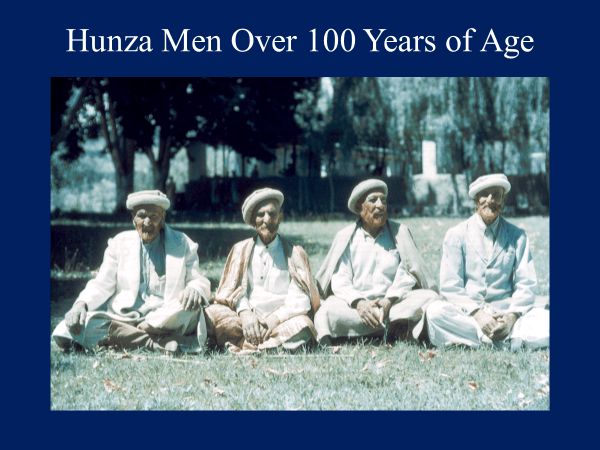
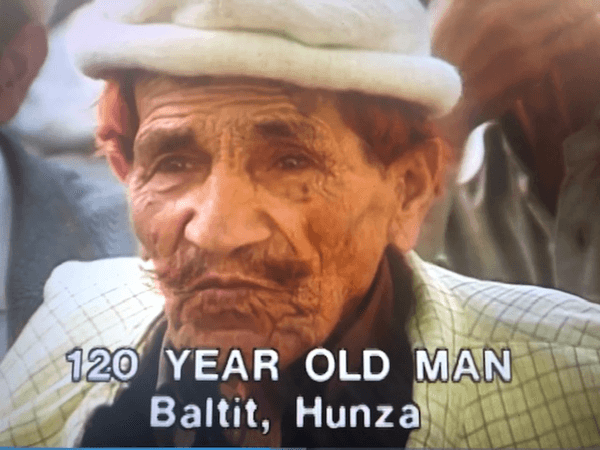
The Hunza Valley is famous for its natural beauty and considered one the earth’s most stunning paradises. During the 20th Century there have been many expeditions to Hunza, some of which have been featured in National Geographic magazine. In the 1920s, the eminent British physician and nutrition researcher Sir Robert McCarrison was the first to conduct scientific studies on the Hunzas and their diet. He reported, “My own experience provides an example of a race unsurpassed in perfection of physique and in freedom from diseases in general. . . I refer to the people of the State of Hunza. . .amongst these people the span of life is extraordinarily long.” During the 1960s and 1970s several researchers and physicians visited Hunza to study their health and longevity. In 1961 an article that appeared in the Journal of the American Medical Association reported that there was evidence that men in Hunza land live to be 120 and even 140 years old. In 1964, renowned cardiologist Dr. Paul Dudley White (a Founder and past President of the American Heart Association and cardiologist to President Dwight Eisenhower) and his colleague from Harvard Medical School traveled to Hunza where they examined and studied 25 Hunza men. Reporting their findings in the American Heart Journal, the Hunza men were “on fairly good evidence, between 90 and 110 years old.” Not one of these men showed a single sign of coronary heart disease, high blood pressure or high cholesterol. In 1973, Harvard physician and research scientist on longevity, Dr. Alexander Leaf reported in National Geographic Magazine on his journey and research in Hunza. “. . .I had the definite impression of an unusual number of very vigorous old folk clambering over the steep slopes that make up this mountainous land. It was the fitness of many of the elderly rather than their extreme ages that impressed me.” In analyzing the Hunza diet, Dr. Leaf found the average daily Hunza diet provides its protein and fat calories predominately from plant sources. The diet was rich in complex carbohydrates from unrefined whole grains and other healthy plant foods. He found meat and dairy products to “constitute only 1 ½ percent of the total.” “Fats of animal origin are scarce; instead the oil obtained from apricot seeds is generally used for all culinary purposes,” he stated. Dr. Leaf concluded that the diet of Hunza “would delay the development of atherosclerosis – that is, fatty deterioration of arteries of the heart.”
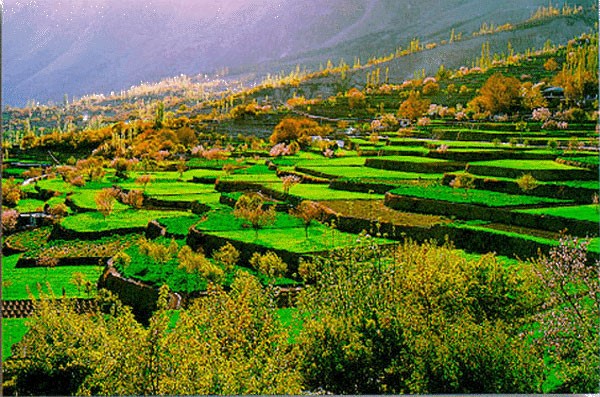
Terraced Organic Farming of Hunza
Due to the geography and unique environment of the Hunza Valley, the people of Hunza naturally live a very healthy lifestyle. Their healthy lifestyle characteristics are very similar to that of the long-lived Blue Zone populations previously mentioned. The people of Hunza live very active and vigorous lives with young and old alike being industrious as they work the terraced fields tending to their gardens carefully raising their organic foods in the fresh mountain air and sunshine. They get plenty of exercise all day long climbing up and down the terraces on their farms. The pure water they drink comes directly from the glacial streams found in the high Himalayas. They primarily eat a vegetarian-type diet. Most of the protein they eat comes from plant sources such as beans and legumes. They enjoy whole-grain chapatti bread (a delicious flat unleavened bread) at almost every meal. The Hunzakuts eat an abundance of organic fruits and vegetables. Apricots, both fresh and dried (and the kernels inside them) are a main staple in the Hunza diet and are famously thought to be a major reason for their legendary health and longevity. Other fruits they consume include mulberries, cherries, apples, peaches, grapes, and pears. Vegetables in the Hunzakut diet include leafy greens, potatoes, carrots, turnips, squash, onions, and garlic. Eighty-percent of vegetables are eaten raw with their skins and the remaining twenty-percent are usually lightly steamed. They get their essential fatty acids from eating nuts (walnuts are a dietary staple), apricot kernels and its oil (use the oil only sparingly). In addition to the glacier water, they also drink herbal tea. They do not drink coffee.
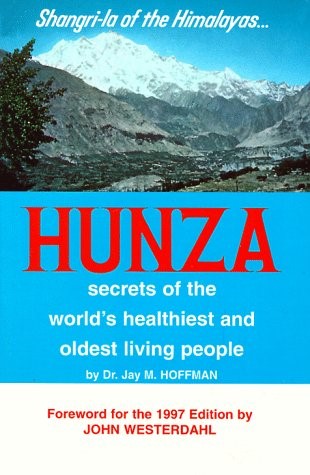
During the 1960s and again in the 1980s, Dr. Westerdahl’s colleague, Dr. Jay M. Hoffman traveled to Hunza to do extensive research on the Hunzakut’s health and longevity. Dr. Westerdahl is currently updating Dr. Hoffman’s original book and research and will release a new edition of the book in 2021.
“There are many lessons we can learn from these cultures of longevity as we examine the healthy lifestyle habits of the people who live in these Blue Zones and in Hunza. You too can establish your own Blue Zone at your home or residence. You can apply the Blue Zone healthy lifestyle principles wherever you go in your travels. By doing so you can add years to your life and life to your years.”
- Dr. John Westerdahl
Dr. John Westerdahl is a graduate of Loma Linda University School of Public Health located in Loma Linda, California (“The Blue Zone of America”). Dr. Westerdahl, a former Vice President of the Hunza Research Society and active member of the American Academy of Anti-Aging Medicine, is a Board Certified Anti-Aging Health Practitioner and Registered Dietitian Nutritionist (RDN) specializing in longevity and anti-ageing nutrition and health. He can tailor a science-based nutritional and anti-ageing lifestyle program to help you achieve optimal health and longevity. His goal is to help people in “Living Healthier and Younger Longer”. Call Dr. Westerdahl at (805) 722-7958 or complete our Contact Form to make an appointment. You can pre-purchase your counseling and services in advance at Dr. Westerdahl’s online Get Healthy Store.

